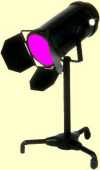When looking at the history of gays on television, size doesn’t matter.
Though the raw number of homosexual characters on prime-time series is still miniscule — particularly on broadcast TV — the depth and richness of their portrayals has grown exponentially.
Call it personality tube lube.
Hard to believe, but it’s been almost 30 years since Billy Crystal played the first gay running character on a series: Jodie Dallas, on ABC’s then-controversial satire Soap.
We’ve come a long way in three decades, babies.
gay running character on a series: Jodie Dallas, on ABC’s then-controversial satire Soap.
We’ve come a long way in three decades, babies.
Their numbers may be small, but gays are playing large with mainstream America . We’re not talking niche networks here. We’re talking N-B-C, for one. We’re talking big, boffo hits like Will & Grace, which ended its eight-season run in May.
The first mainstream-network smash with gay lead characters, W & G proved that Americans would embrace a straight-looking queer who never had sex and a goofy-looking queen who never stopped — as long as they made them laugh.
The key? Characters with layers. Texture. Nuance. Playing to and against type.  Created by great writers and producers, many of whom were gay. At W & G’s height, more than 17 million viewers tuned in each week to watch the queer boys. Advertisers paid top dollar.
W & G’s success made it cool to be queer on TV.
Created by great writers and producers, many of whom were gay. At W & G’s height, more than 17 million viewers tuned in each week to watch the queer boys. Advertisers paid top dollar.
W & G’s success made it cool to be queer on TV.
And premium cable, with no restrictions on language and content, was off and running. There was Showtime’s queerasfolk, featuring a cast of gay studs in heat. Then it was the girls’ turn, with beautiful lesbians bumping uglies on the The L Word, also on Showtime. The moral center of HBO’s Six Feet Under was a gay undertaker.
Even TV’s butchest show, HBO’s The Sopranos, got into the act last season with Tony’s top earner turning out to be a closet queer. In the reality genre, the boys of Bravo’s Queer Eye for the Straight Guy became media darlings. Reichen and Chip, then a couple, won season four of CBS’s Amazing Race. Gays are routinely included in Bravo’s Project Runway (duh) and Top Chef. There are even two gay cable networks — Logo and here! (CQ) Pre-Will & Grace, two major factors increased gay visibility: The integration of gay characters into popular mainstream shows, and the proliferation of gay writers and producers pushing the envelopes on their own series. ABC’s Roseanne (1988-97), a breakthrough comedy, featured a gay wedding and a bisexual character played by Sandra Bernhard.
Innkeepers Ron & Erik tied the knot on CBS’s Northern Exposure in 1994. The same year, HIV-positive gay man Pedro Zamora became a cult hero on MTV’s The Real World. In the numbers game, however, gay characters continue to barely register a pulse on the TV landscape.
Only 1.3 percent of all scripted-series regulars on the ‘06-‘07 schedules of the six major broadcast networks are homosexual, according to an analysis by the Gay & Lesbian Alliance Against Defamation. Last season, it was a whopping 1.4 percent. In cable and unscripted shows, GLAAD counts 25 series regulars, one fewer than last year. L’est we forget, it was a woman who broke open the doors.
Remember what a huge deal it was when Ellen DeGeneres and her sitcom character both came out in April 1997? “The Puppy Episode” drew a mondo 34 million viewers, but the next season, Lesbianism 101 replaced comedy and the show tanked. Now DeGeneres is a hugely-successful daytime chat show host. She never talks about her sexuality.
Coincidence? You decide. Our representation remained low, if not invisible until the 99-00 season on broadcast networks (it began to climb on cable in 1993), since the beginning of this century it's remained relatively consistent with some minor fluctuations.
*by Gail Shister, 365Gay.com
No comments:
Post a Comment